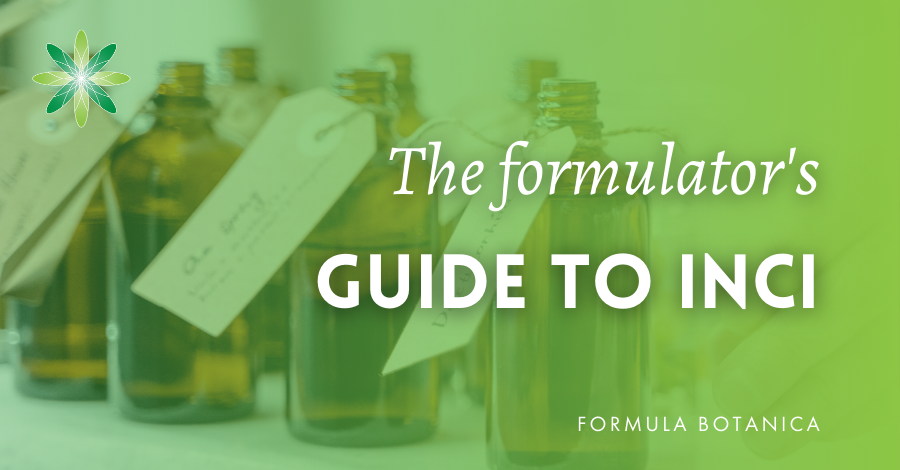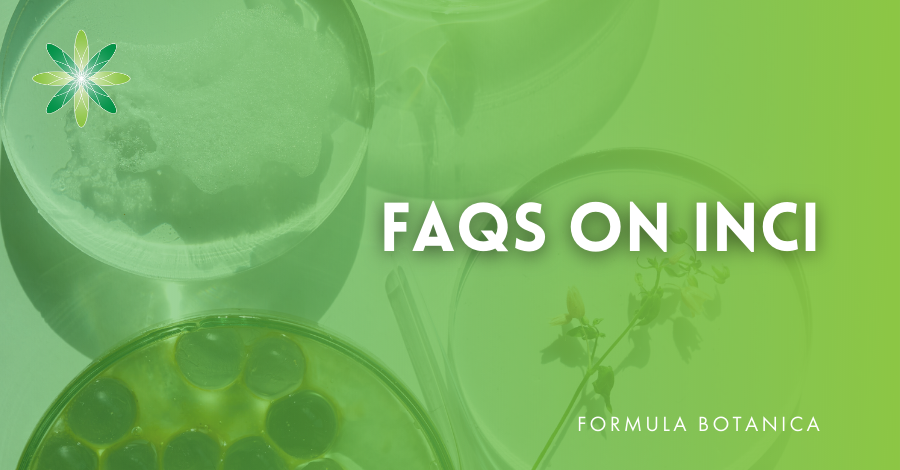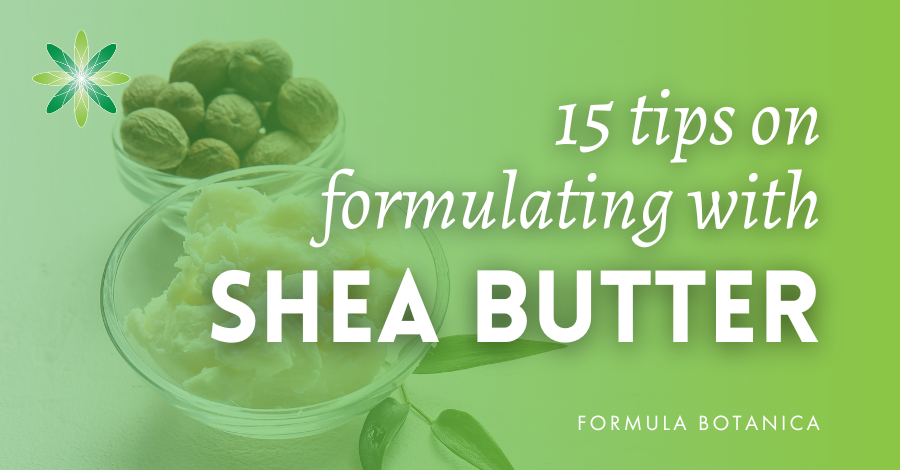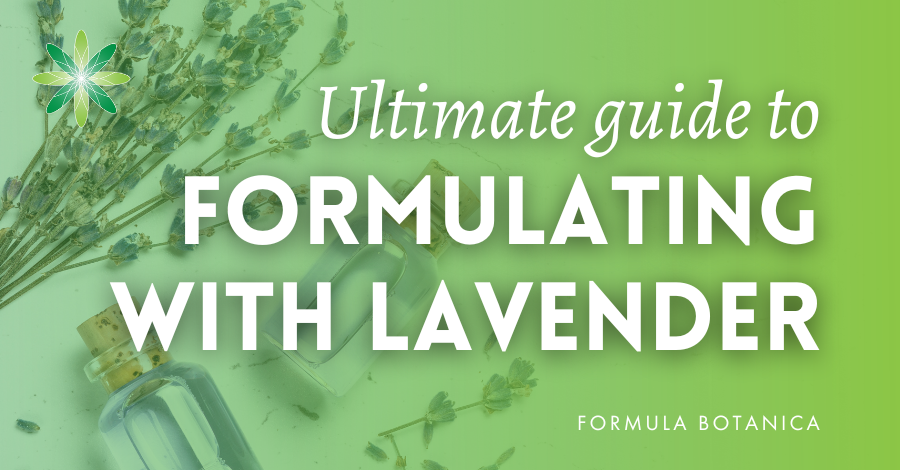Languages are fascinating cultural references and means of communication and it is incredible to think the world has over 7,000 different known languages. Imagine then the confusion if the ingredients’ lists on cosmetic packaging in our now global personal care industry were in thousands of languages.
For ease of global trade, consumer safety and the regulation of personal care products, cosmetic ingredients whether of botanical or synthetic origin are assigned standardised names recognised the world over. They are listed in the International Nomenclature of Cosmetic Ingredients, known commonly by its acronym INCI.
In this formulator’s guide, we explain what INCI is, how it works and why you, as a natural cosmetic formulator, need to be familiar with it in your daily work. From buying ingredient supplies to getting a cosmetic product safety assessed to go on sale, INCI plays a huge role in the life of the cosmetic formulator.
Don’t worry if INCI is new to you; it is common sense to use, even if it takes a little time to understand at the start of your cosmetic formulation career. INCI may not resolve all your queries about the origins and types of cosmetic ingredients you come across, but it goes a long way to helping.
The origins of INCI
The International Nomenclature of Cosmetic Ingredients was started in the 1970s by the US-based Cosmetic, Toiletry & Fragrance Association (CTFA) which is now called the Personal Care Products Council (PCPC). Its origins in the USA are part of the reason INCI names include common English words for some ingredients.
To date, there are over 16,000 cosmetic ingredients listed on INCI, with more added each year as new ingredients are extracted from botanicals or lab synthesised. The list is overseen and new ingredients approved and assigned their INCI name by an independent body, the Cosmetic Ingredient Review (CIR), also established in the 1970s by the then CFTA with the support of the U.S. Food and Drug Administration (FDA) and the Consumer Federation of America.
Where to find INCI
These links take you to the official INCI listing itself, as well as similar cosmetic ingredients’ directories in other parts of the world.
wINCI – the Personal Care Product Association’s online database of over 22,000 cosmetic ingredients in its directory. It is an expensive, subscriber-only service however.
EU Cosing database – a free, online service. You can search the entire database of EU cosmetic ingredients including those banned and restricted in the EU.
Chinese Cosmetic Ingredient Regulatory Database (China CosIng)
Australian Inventory of Chemical Substances (AICS) which includes some cosmetic ingredients.
Why INCI?
There are many benefits to INCI. We mentioned earlier the confusion of having different names circulating for the same cosmetic ingredients. INCI was devised also to simplify often very complex chemical molecular names for ingredients. While the scientific community would understand these chemical names, consumers may find them obtuse or confusing. In addition, long scientific names may be impractical to place within the limited space available on cosmetics’ packaging.
INCI exists therefore to help:
Scientific research: standardised names are important to scientists who need to access and share research to add to the body of knowledge on ingredients. However, not all scientists do use INCI as routine.
Chemical and cosmetics’ manufacture: industry needs to know which ingredients they are dealing with so they can be sure of a cosmetic product’s safety and access research on ingredients in developing their formulations. This is the case for indie, natural cosmetics’ formulators too.
Regulators of cosmetics: the EU and the FDA in the States, as well as other regulatory bodies around the world need to know the precise ingredient they are commissioning research on and adjudicating in formulations in order to determine an ingredient’s safety or to restrict or even ban its use in personal care products within their geographic jurisdictions.
Consumer information and safety: above all, of course, consumers need to have the INCI listing of ingredients available on the primary packaging – the outside of cosmetics’ products – in order to discover any allergens or ingredients they may have adverse reactions to, or simply wish to avoid in cosmetics out of personal choice. With INCI listings of ingredients on cosmetic packaging, and with consumers being more informed about ingredients, there is less chance of marketing hype and greenwashing.
In brief, improved safety, smooth trade, ease of manufacturing and increased scientific knowledge of ingredients underpin the rationale for INCI. The INCI system is used in the United States, the European Union, China, Japan, and many other countries, for listing ingredients on cosmetic product labels. With few exceptions, the INCI labelling names in all countries are the same.
How does INCI work?
When you scan the ingredients on cosmetics’ packaging, you should see INCI in action (we say ‘should’ as declaring ingredients as an INCI list is not mandatory in all regulatory jurisdictions across the world). INCI uses a combination of scientific, English and Latin names as the unique identifiers of cosmetic ingredients. Let’s give some examples of INCI names you might be familiar with before we explain them in detail:
| Common name | INCI |
|---|---|
| Sunflower oil | Helianthus Annuus (Sunflower) Seed Oil |
| Jojoba | Simmondsia Chinensis (Jojoba) Seed Oil |
| Olive oil | Olea Europaea (Olive) Fruit Oil |
| Lavender oil | Lavandula Angustifolia (Lavender) Oil |
| Aloe vera leaf gel | Aloe Barbadensis Leaf Juice |
| Vitamin E | Tocopherol |
| Glycerine | Glycerin |
| Beeswax | Beeswax / Cera Alba |
| Cetyl alcohol | Cetyl Alcohol |
| Rose hydrosol | Rosa Damascena Flower Water |
| Rice powder | Oryza Sativa Kernel Powder |
Looking at the table, you will see a mix of names comprising the INCI: English common names; Latin names; and scientific names. Sometimes all three may be combined in one INCI listing. Some names don’t change. Beeswax and glycerin are two examples of this (note: glycerine is the UK English spelling). Note that beeswax is also found under another INCI – Cera Alba – so you will come across both.
For botanical ingredients, the scientific part of INCI names is based on the Linnaean binomial system or the two-part naming system based on a plant’s genus followed by its specific name. It is named after the 18th century Swedish medic and botanist Carl Linnaeus – the father of taxonomy – who is credited with formalising the system to categorise plants, fungi and algae.
Using the Linnaean system, Rosa damascena denotes first that the plant is a ‘rose’ and then that it is a damask rose. A dog rose using the Linnaean system is Rosa canina. You can see that we should write this part of the INCI a specific way: the first word, the genus name, is capitalised, and the species name is in lower case, and the entire name in print should be italicised.
While this is strictly correct, you will not always see Linnaean names in italics on cosmetics’ packaging or online in product descriptions. This is because italics can be hard to read in some fonts and colours and may be difficult to decipher.
Using INCI on cosmetics’ packaging
Writing your formulations down in the common name as well as the INCI ingredient names is best practice in cosmetic formulation. This is especially important when you wish to replicate a formulation later on or go on to sell a cosmetic product you’ve made. In the EU, and most other jurisdictions, any cosmetic product placed for sale must be safety tested by a qualified assessor who will require your formulation written in INCI and in the correct percentage order.
In the EU and the US, you are obliged to list your formulation’s ingredients on your packaging in order of scale, from the largest percentage ingredient downwards to those included at one per cent. Ingredients present at less than one per cent, including any of the regulated allergens present in your formulation, can be listed in any order. The consumer – and other formulators – then have a good idea of the amount of any ingredients in the product if not the precise formulation breakdown.
In the US, personal care product ingredients’ listings must be in the common name, but do not need to be suffixed with the INCI name in brackets although it is common to see them written as in these examples: Water (aqua) and Fragrance (parfum). In the EU, and other jurisdictions, the INCI name is mandatory with any common name voluntarily added after in brackets. Detailed information on labelling is beyond our scope in this article, but these links explain US and EU cosmetics label requirements:
USA – Cosmetics Labeling Requirements
EU – Understanding cosmetics labels
EU Cosmetics Regulation
Podcast episode 3: How to comply with cosmetics regulations
FAQs on INCI
First, let’s stress that INCI names are the first place to go when you want to know more about your ingredients. Whether writing up a draft formulation or deciding what to buy from suppliers, INCI names hold the clues to your ingredients. However, INCI still has some grey areas. We have compiled some of the most frequently-asked questions about INCI we receive from our school community.
1. Is this ingredient natural?
Reading the INCI will give you clarity on an ingredient’s components and help you determine if it is natural or any of our so-called 4 shades of natural.
For instance, some waxes may be ‘pseudo waxes’ and not the pure extracted botanical waxes you think they are. Their INCI names will give clues to their provenance. Similarly, the INCI name can help you determine if a hydrosol is the product of distillation or a floral water created by solubilising essential oils into distilled water. These two articles are examples of how vital decoding the INCI is in choosing and buying the natural ingredients.
6 vegan waxes for organic cosmetic formulations
How to spot a fake hydrosol
However, even the INCI name cannot give you 100 per cent clarity on an ingredient and you may need to do more research on ingredient origins.
In some cases, the INCI name is the same whether the ingredient is the botanical or synthetic version. An example of this is propanediol, a solvent and emollient used to enhance the skin feel and texture of cosmetics. It can be fermented from corn or produced by synthesis. The hydrosol post we linked to above has examples of the same INCI being used for products formulated and produced differently.
The ingredients glycerine and squalane can be from vegetable and from animal origin, yet the INCI is the same for both. You will need to become aware of products that have different origins but the same INCI. Cosmetic ingredient research is everything.
2. Why do different products have the same INCI?
Ingredients may comprise the exact same chemical components but in differing ratios. In this case, the INCI can’t tell you the percentage makeup of the total ingredient. An example of this would be two emulsifiers that have the same INCI but would need to be worked with differently in a formulation and perhaps give a different feel on the skin in the finished product. They may have different trade or proprietary names, but the same INCI.
Another reason is that the INCI given does not explain which part of the plant an ingredient is derived from. An example of this would be the sea buckthorn plant which produces two botanical oils – one pressed from its seeds; the other from the flesh of the berry – that have very different fatty acid profiles. Both may be referred to as Hippophae rhamnoides oil in supplier’s information instead of Hippophae rhamnoides seed oil and Hippophae rhamnoides berry oil. Safety assessors will ask you for the part of the plant your ingredients are from, so be sure you know.
Be aware too that suppliers often combine ingredients to add antioxidants and preservatives to extend their shelf life. Continuing with the sea buckthorn oil example, you might come across combinations like these:
- INCI: Sesamum Indicum (Sesame) Seed Oil (and) Hippophae Rhamnoides Fruit Extract (and) BHT (and) Ascorbyl Palmitate. This is sea buckthorn combined with sesame oil, a lipophilic version of vitamin C, along with Butylated Hydroxytoluene or BHT which is an antioxidant, stabiliser and preservative. The BHT would not be compatible with natural formulation.
- INCI: Hippophae Rhamnoides Fruit Extract (and) Rosmarinus Officinalis (Rosemary) Leaf Extract. This sees sea buckthorn berry fruit extract in combination with rosemary leaf extract which is an antioxidant.
Just to confuse matters more, the same INCI can sometimes represent totally different products. For example, the INCI Rosmarinus Officinalis Leaf Extract can represent a CO2 extract, an oil extract, a glycerite, or even a powder extract.
You need to ask your suppliers for more information therefore on the percentage of the component ingredients present that constitute an ingredient, and also, if it is not clear, about the part of the plant an ingredient comes from and about the type of product (CO2, cold-pressed oil and so on). Try to obtain the safety data sheets (SDS) and certificates of analysis (COA) from the manufacturer to obtain more details.
3. Does every cosmetic ingredient have an INCI?
No, not every ingredient permissible in cosmetics need have an INCI. For example, some ingredients derived from food sources may not be listed as cosmetic ingredients and therefore do not have an INCI listing. Fresh banana extract could be listed on the ingredients but it would not have a corresponding INCI.
4. Does INCI tell you what the source of the ingredient is?
No, you can’t always find out the source, whether botanical or synthetic, from all INCI listings alone. For example, the common oil Caprylic/Capric Triglycerides can be made from several ingredients including coconut and palm kernel oils blended with various medium-chain triglyceride (MCT) oils and glycerol. You need to ask your supplier for the documentation – SDS and COA – to determine the exact sources of some ingredients.
5. Are all ingredients listed on INCI safe to use in cosmetics?
The Personal Care Products Council says on its site that the fact a cosmetic ingredient has an INCI does not make any statement about its safe use in cosmetics. This judgement lies with the regulatory authorities in various jurisdictions around the world. Manufacturers, and you as a natural formulator, need to use this regulatory information in developing safe formulations.
6. Does the INCI say how active or effective an ingredient is?
The fact that you see a nice botanical or active ingredient named in the INCI does not mean the product is a powerhouse of botanical goodness for your formulations. Let us take the issue of a plant extract in an aqueous base. Centella asiatica or Gotu kola is known as an adaptogen, and excellent in formulations aimed at mature skin. Its key active chemicals are its centelloids – asiaticoside, madecassoside, asiatic acid, and madecassic acid. But the INCI of a Gotu kola extract in water would simply state the plant’s Latin name and water and not give any indication of the amount of active ingredients within the solution.
Similarly, hyaluronic acid comes in different molecular weights which are suited to different types of cosmetic preparations and used for different reasons. The INCI name for hyaluronic acid is Sodium Hyaluronate and would be the same whichever molecular weight you buy. Again, you need to drill into supplier documentation and ask questions to be sure of what you are buying.
7. Where do I find an ingredient’s INCI?
First, look at your supplier’s paperwork, and if you don’t find the INCI for an ingredient ask for it. If you intend to use that ingredient for a product to sell, you will certainly need the INCI. Look up the ingredient on INCI and freely-accessible ingredient databases such as the EU’s CosIng database or SpecialChem and try also ingredient trade portals like UL Prospector and Covalo whom we interviewed in Podcast 79: The challenge of sourcing natural ingredients.
8. How do I write the INCI for macerates or glycerites I make at home?
At Formula Botanica, we advise our students to give the INCI name of the solvent (carrier oil/water/glycerine/ethanol or combination of solvents) and the botanical name of the plant extract. To write the INCI of a plant extract you need to write the INCI used for the plant (which isn’t always its botanical name) and the part of the plant used. It is possible to check the plant’s INCI on the EU’s Cosing database of ingredients.
These examples show this in action:
- Rosemary oil extract (this is also an example of INCI that doesn’t use the updated botanical name – which is now Salvia rosmarinus): Helianthus Annuus (Sunflower) Seed Oil (and) Rosmarinus Officinalis Leaf Extract
- Green tea glycerite: Glycerin (and) Aqua (and) Camellia Sinensis Leaf Extract
It is fun to make glycerites and macerates at home, but if you intend to use them in cosmetic products to sell, we recommend you buy them from reputable suppliers who can provide the required documentation (SDS and COA). This is because you will need your cosmetic products safety assessed before they can go on sale, and your assessor will need accurate, lab-certified documentation about your ingredients. These links help explain all about working with glycerites and macerates:
The formulator’s guide to glycerites
How to make macerated oils
Guide to choosing the best herbal solvent
9. Where do I find an ingredient’s percentage breakdown?
Either the SDS and/or COA should provide this information for compound ingredients. If not, ask your supplier to provide comprehensive documentation. If they can’t and you need it, buy elsewhere.
FREE TRAINING
Learn how to become an
Organic Skincare Formulator
FREE TRAINING
How to become an
Organic Skincare Entrepreneur
FREE TRAINING
How to become an
Organic Skincare Entrepreneur
Leave us a comment

Liz was Formula Botanica’s Content Coordinator between August 2020-2024. Liz worked as a professional blogger, journalist and site developer for many years and was also part of the Formula Botanica student community. Read more about the Formula Botanica Team.




























